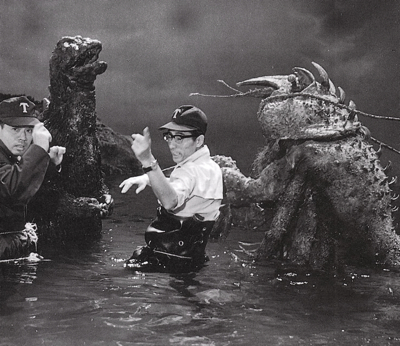
Sadamasa Arikawa (center) directing Haruo Nakajima (as Godzilla) and Hiroshi Sekita (as Ebirah).
GODZILLA VS. THE SEA MONSTER
Gojira-Ebira-Mosura Nankai-no Daiketto, 1966, 87 minutes
Director JUN FUKUDA • Visual Effects SADAMASA ARIKAWA • Visual Effects Supervisor EIJI TSUBURAYA
In 1965, there was a big change in the Visual Effects Department at Toho, with contracts ending and Tsuburaya pulling people and resources over to his own effects company, Tsuburaya Productions. Since he was spending so much time at his own studio, Tsuburaya chose his cinematographer, Sadamasa Arikawa, to divide chores as Visual Effects supervisors. Since Honda and Tsuburaya were busy with international co-productions (such as THE WAR OF THE GARGANTUAS), Tanaka handed the next Godzilla project over to popular action film director Jun Fukuda, who previously helmed the sci-fi thriller SECRET OF THE TELEGIAN (1960) and the colorful action-comedy 100 SHOT/100 KILLED (1965).
America's Rankin/Bass Productions, famous for its puppet animated television specials produced in Japan (such as "Rudolph the Red-Nosed Reindeer"), was shopping studios to take on a live-action feature film, based on their KING KONG cartoon series, produced by Toei Animation. The first screenplay, penned by Shinichi Sekizawa ("King Kong vs. Ebirah: Operation Robinson-Crusoe"), was rejected, but as negotiations continued, writers were put to work to submit further treatments which were offered to Rankin/Bass (eventually becoming KING KONG ESCAPES in 1967). While Toho was busy creating new monster films, such as THE WAR OF THE GARGANTUAS, there were no Godzilla projects on the boards for 1966,
The general consensus was that the Godzilla series needed a fresh direction, the relatively new medium of television was also keeping people away from theaters, so Tanaka thought that it was time to go after the teenage market with the same very same formula that made films such as the YOUNG GUY (starring Yuzo Kayama) so popular. There was also a very trendy interest in the exotic tropics, Hawaii and the South Seas, reflected in Japanese pop songs and movies of the early-to-mid-1960s. Tanaka thought that this could be exploited with the rejected screenplay for "King Kong vs. Ebirah," which incorporated these elements perfectly. Tanaka ordered the project into production, substituting Godzilla for King Kong, in a slightly revised screenplay entitled "Godzilla-Ebirah-Mothra: Big Duel in the South Seas."
The cast was top-lined by leading man Akira Takarada, the biggest box-office draw at the studio, playing the is-he-isn't-he master thief, who adds a worldly presence to the mostly youth cast. As the beautiful escapee, 29 year-old Mizuno was a last-minute marquee-value replacement for 19 year-old Starlet Noriko Takahashi (the dancing girl in FRANKENSTEIN CONQUERS THE WORLD), who originally was cast in the part, but fell ill due to acute appendicitis during principal photography. The driving electric guitar and jazz-infused soundtrack was composed by Masaru Sato (YOJIMBO) scoring his second Godzilla film (the first was GODZILLA RAIDS AGAIN in 1955) was quite a departure from Akira Ifukube’s bombastic marches. The lush photography was in the hands of Kazuo Yamada, who shot the majority of Hiroshi Inagaki’s memorable films, including CHUNSHINGURA (1962).
Fukuda approached this as pure escapism, with a fast-paced story that also weaves in Youth Movie elements with James Bondian histrionics — Takarada's hot-headed safecracker, a sinister organization bent on world domination through nuclear proliferation, and a band of teenagers swept up into the action, with whom the target audience could indentify. It is quite apparent that little was revised in the changing of the central monster from Kong to Godzilla, because of the odd Kong-like ticks adopted by Godzilla — his attention directed at a beautiful woman, his battles with a Giant Condor and a Jet Squadron, his boulder-throwing antics, and the rubbing of his nose (ala Kayama's character in the aforementioned YOUNG GUY series). The colorful film is an unusual, but highly enjoyable, adventure — despite its relatively lower budget — and is one of the most underrated of the 1960s entries.
(It's also the only Godzilla film to open with a Go-Go Contest!)
Executive Producer TOMOYUKI TANAKA Screenplay SHINICHI SEKIZAWA Production Design TAKEO KITA Cinematographer KAZUO YAMADA Film Editor RYOHEI FUJII Music MASARU SATO Visual Effects Production Design YOSHIYUKI INOUE Visual Effects Photography SOKEI TOMIOKA and YOICHI MANODA
AKIRA TAKARADA (Yoshimura) KUMI MIZUNO (Dayo) TORU WATANABE (Ryota) TORU IBUKI (Yatta) CHOTARO TOGIN (Ichino) HIDEO TSUNAZUKA (Niita) JUN TAZAKI (Outpost Commander) AKIHIKO HIRATA (Captain Dragonpatch) HISAYA ITO (Nuclear Physicist) HIDEYO AMAMOTO (Ship Captain) CHIEKO NAKAKITA (Kane, Ryota and Yatta's Mother) FUMIKO HONMA (Shinto Medium) IKIO SAWAMURA (Old Infant Islander) and THE BAMBI PAIR (The Little Beauties)






































6 comments:
I always learn more about these movies reading your blog entries. Thanks August!
I was impressed by this movie when I first saw it. It is extremely underrated and deserves to be seen or re-visited.
Thanks August.
As much as I thoroughly enjoy almost all of the original series, especially the '60s entries, I've always felt that the beginning of the "Fukuda Era" represented a drastic drop in quality. And definitely a noticeably shift towards a younger audience, as you indicated here.
Watching the film on television, even with the remastered domestic R1 or the Japanese R2, just doesn't have the proper impact that seeing this in a theater — a real theater with a humungous screen — has.
You simply must see the 35mm subtitled print that Sony Repertory has for theatrical rental — the colors leap off the screen and assault your optic nerves — you'll never look at this film the same way again. It's a revelation in a theater.
Cheers,
August
Man I would love to see this in a theater. This was one of my favorites as a kid, I really got into the espionage aspect. Not to mention catching little "sea monster" (crawdads) in the drainage canal near my house. We even ate them once.
I always had a good feeling about this film and was disappointed to hear criticism of it later in my life. I haven't seen it in years, but I know it needs another viewing in Nihongo.
If you live near a repertory theater that screens revivals of classics, you might want to let them know that Sony Repertory has quite a few Godzilla films, including this one for booking.
In the meantime, you should pick up the beautiful bi-lingual DVD — in glorious TohoScope — from Sony Home Video. But, beware, the English dialogue tracks are not the same that was initially released in the US, and is not very good.
But, you can always watch it in Japanese with English subtitles!
Cheers,
August
Post a Comment